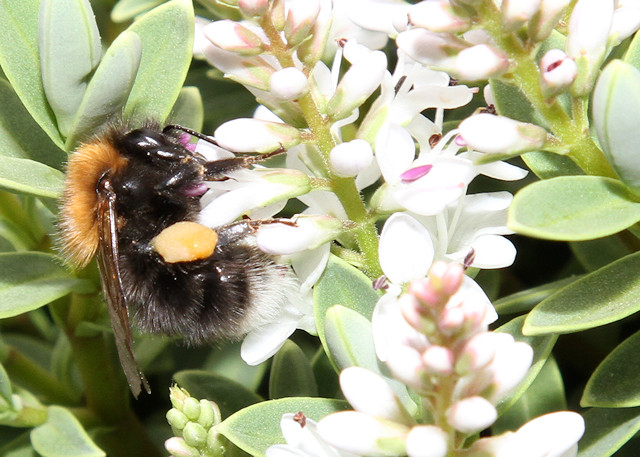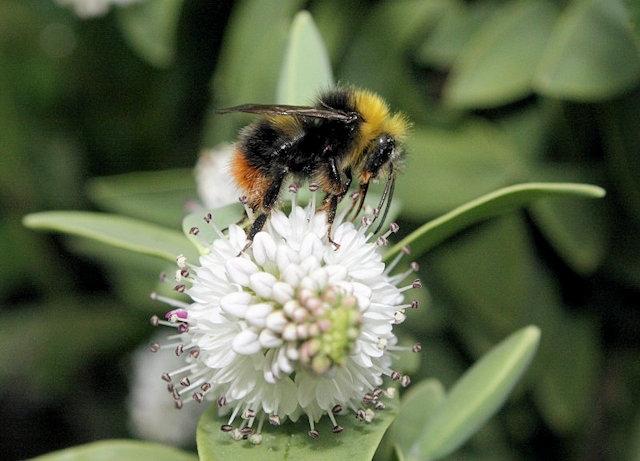How you can prevent the plight of the bumblebee
Date published: 25 May 2019

Photo: Rochdale Online
A tree bumblebee
Monday 20 May was World Bee Day, a day to champion our favourite pollinators, but how can we help fight their decline?
According to the Bumblebee Conservation Trust, declines in our bumblebee populations have occurred mainly because of large-scale changes to countryside management, including a public demand for cheap food, a constant demand for food and crops, not to mention less wildflowers.
97% of flower-rich meadows have been lost since 1937, just one action to have detrimentally affected bumblebee numbers.
Bumblebees only feed on flowers, requiring enough flowers to sustain a colony of hundreds over several months. Rarer species don’t venture far to forage, needing large quantities of diverse flowers to sustain their colonies.
A spokesperson for the Bumblebee Conservation Trust said: "The easiest way to help our bumblebees is to plant wildflowers to flower between March and September.
“Pollinator-friendly gardening is very important whether you have a balcony, a windowbox, a big garden, a road verge or a park.
“Although people often champion honeybees, which are mainly domesticated, the honeybee only visits a proportion of plants but a long way from all of them: recent research showed about 7% of flower visits were honeybees across gardens, parks, road verges, nature reserves and crops.
“Wild bees – bumble and solitary bees – are therefore essential for pollination and food production.”

Bee-friendly pollination and flowers
Bumblebees are very important for pollinating wildflowers and fruits: many commercial crops such as tomatoes, peas, apples and strawberries, are helped by pollinators and insects are estimated to contribute over £600 million per annum to the UK economy.
The Bumblebee Conservation Trust warns that, if the bumblebee decline continues, the extremely high cost of pollinating these plants by other means could significantly increase the cost of fruit and vegetables (hand-pollinating British crops has been estimated to cost £1.8 billion annually).
You can help by planting flowers like borage, hellebore, lungwort, comfrey and catmint in the shade, whilst herbs, crocuses, lavender, geraniums, honeysuckles and sunflowers are perfect food for bees in the sun.
Don’t forget to check toxicity of flowers before planting as some varieties can be harmful to pets and children.
Certain plants have flower shapes that bumblebees cannot use - some flowers have petals that form long tunnels which are too long or narrow for the bees to feed from. Similarly, flowers with multiple tightly packed heads offer bees very little accessible food.
Other flowers may not be suitable because they produce little or no pollen and nectar, such as pansies and double begonias.
You should avoid using any pesticides in your garden. They are often labelled as 'bug killers' or something similar, but almost all of these can harm bumblebees, even if you don't intend to harm them.
Do you have a story for us?
Let us know by emailing news@rochdaleonline.co.uk
All contact will be treated in confidence.
Most Viewed News Stories
- 1Former councillor and hospital campaigner Jean Ashworth has died
- 2Middleton school hails another outstanding inspection result
- 3Northern Healthcare opens supported living service in former Rochdale hotel
- 4Family event to celebrate Earth Day to be held at Number One Riverside
- 5No trams between Oldham and Rochdale this Sunday
To contact the Rochdale Online news desk, email news@rochdaleonline.co.uk or visit our news submission page.
To get the latest news on your desktop or mobile, follow Rochdale Online on Twitter and Facebook.


